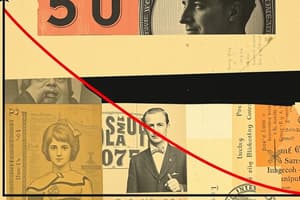Podcast
Questions and Answers
What does the law of supply state?
What does the law of supply state?
Other things remaining the same, the higher the price of a good, the greater is the quantity supplied; and the lower the price of a good, the smaller is the quantity supplied.
What can a supply curve be interpreted as?
What can a supply curve be interpreted as?
A minimum-supply-price curve.
What is marginal cost?
What is marginal cost?
The lowest price at which someone is willing to sell, shown in a supply curve.
A rise in the price of a cellphone ______ the quantity supplied and ______ supply.
A rise in the price of a cellphone ______ the quantity supplied and ______ supply.
What are substitutes in production?
What are substitutes in production?
What happens at the equilibrium price?
What happens at the equilibrium price?
What is the formula for the equilibrium quantity?
What is the formula for the equilibrium quantity?
What is the formula for the equilibrium price?
What is the formula for the equilibrium price?
What defines a competitive market?
What defines a competitive market?
What is the money price?
What is the money price?
What is relative price?
What is relative price?
What is quantity demanded?
What is quantity demanded?
What does the law of demand state?
What does the law of demand state?
What is demand?
What is demand?
What does the demand curve show?
What does the demand curve show?
What is a change in the quantity demanded?
What is a change in the quantity demanded?
What is a change in demand?
What is a change in demand?
What effect does a rise in the price of a related good (substitute) have on demand?
What effect does a rise in the price of a related good (substitute) have on demand?
What is a complement?
What is a complement?
What effect do expected future prices have on current demand?
What effect do expected future prices have on current demand?
How does income affect demand for a normal good?
How does income affect demand for a normal good?
How does income affect demand for an inferior good?
How does income affect demand for an inferior good?
Flashcards are hidden until you start studying
Study Notes
Law of Supply
- Indicates that with all else held constant, higher prices result in greater quantities supplied.
- Conversely, lower prices lead to smaller quantities supplied.
Supply Curve
- Represents the minimum-supply-price curve, indicating the lowest price a seller is willing to accept.
Marginal Cost
- Relates to the minimum price at which a seller is willing to sell, depicted in the supply curve.
Price Impact on Supply
- An increase in cellphone prices results in a higher quantity supplied but does not alter overall market supply.
Substitutes in Production
- Refers to goods that can be produced using the same resources, allowing firms flexibility in production choices.
Equilibrium Price Dynamics
- At equilibrium price, buyers will pay the maximum they are willing for the last unit, while sellers will receive the minimum they will accept.
Equilibrium Quantity Formula
- Calculated using the formula (a−c)/(b + d).
Equilibrium Price Formula
- Determined by the formula (ad + bc)/(b + d).
Competitive Market Definition
- Characterized by numerous buyers and sellers, ensuring that no single entity can influence the market price.
Money Price
- Refers to the monetary amount that must be exchanged for a good.
Relative Price
- Defined as the ratio of one money price to another, reflecting the trade-offs between different goods.
Quantity Demanded
- Represents the total amount consumers intend to purchase over a specified timeframe at a particular price.
Law of Demand
- States that, all else being equal, higher prices lead to a lower quantity demanded, whereas lower prices encourage higher quantities demanded.
Demand Relationship
- Establishes the connection between the price of a good and the quantity demanded.
Demand Curve
- Visually represents the relationship between quantity demanded and price, holding all other factors constant.
Changes in Demand
- Change in Quantity Demanded: Movement along the demand curve, triggered by price changes.
- Change in Demand: A shift in the demand curve due to factors other than price.
Substitute Goods
- An increase in the price of a substitute good elevates demand for the primary good, shifting the demand curve to the right.
Complement Goods
- An increase in the price of a complementary good decreases demand for the related good, shifting the demand curve to the left.
Expected Future Prices
- Anticipation of higher future prices can lead to increased current demand, shifting the demand curve to the right.
Income Impact on Demand
- For normal goods: An increase in income raises demand, shifting the curve rightward.
- For inferior goods: An income increase causes a decrease in demand, shifting the curve leftward.
Studying That Suits You
Use AI to generate personalized quizzes and flashcards to suit your learning preferences.




